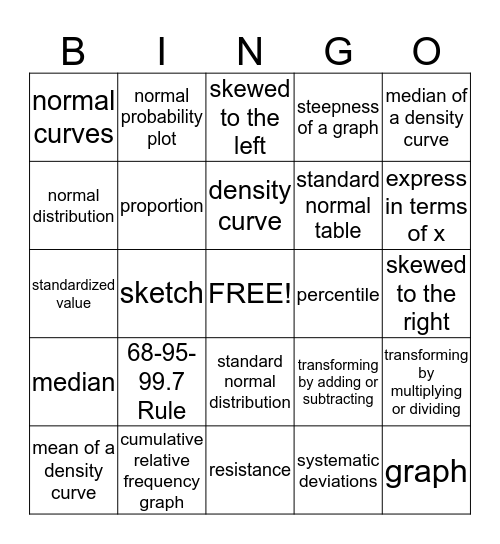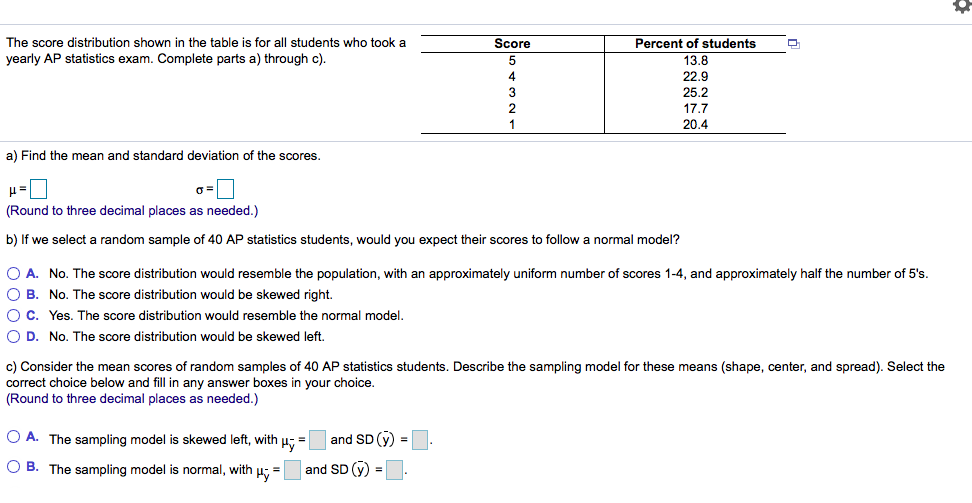- New Ap Statistics Formula Sheet
- Residual Ap Statistics Definition
- Ap Statistics Free Response Answers
- Ap Statistics Course Description
Open to: Grades 8 - 12
The AP Statistics course is equivalent to a first-semester, college-level class in statistics. The 3-hour, end-of-course exam is comprised of 46 questions, including40multiple-choice questions (50% of the exam) and 6 free-response questions (50% of the exam). The exam covers the following course content categories. AP Statistics Course and Exam Description This is the core document for the course. It clearly lays out the course content and describes the exam and the AP Program in general. The AP Statistics Exam is made up of two parts: a multiple-choice section and a free response section. The entire test lasts three hours. Here's how the time is allotted. AP Statistics is an introductory college-level statistics course that introduces students to the major concepts and tools for collecting, analyzing, and drawing conclusions from data.

AP Q&A Statistics is specifically created to help students hone critical thinking skills and practice with all AP-style question types, such as multiple-choice, numeric response, and short and long free-response questions. Looking for in-depth content review along with realistic practice tests? Try Barron's AP Statistics for even more prep.
Eligibility:CTY-level or Advanced CTY-level math score required
Prerequisites: Successful completion of Algebra II or equivalent
Course Format:Individually Paced
Course Length: Typically 6 Months
Recommended School Credit:This is equivalent to a full AP Statistics course.
Course Code: STA
Course Description
Description
This AP Statistics course is an online and individually-paced course covering topics in Probability, Regression Analysis, and Sampling Distributions. While taking the Advanced Placement (AP) Statistics exam is not required, this course prepares students to succeed on the AP Statistics exam and subsequent courses that draw on material from this course. Computer based interactives and homework assignments help to reinforce concepts taught in the course.
Each student is assigned to a CTY instructor to help them during their course. Students can contact their instructor via email with any questions or concerns at any time. Students will learn statistics by reading from the textbook, watching online videos, interacting with online resources, and solving many practice problems through homework and quizzes.
Live one-on-one online review sessions can be scheduled as well to prepare for the graded assessments, which include homework, quizzes, projects, chapter exams, a midterm exam, and a cumulative final. Exams contain both multiple choice and free response questions modeled after the AP Statistics exam. Instructors use virtual classroom software allowing video, voice, text, screen sharing and whiteboard interaction.
This course has been reviewed and approved by the College Board to use the 'AP' designation.
Topics include:
- Exploring data
- Modelling distributions of data
- Describing relationships
- Designing studies
- Probability
- Random variables
- Sampling distributions
- Estimating with confidence
- Testing a claim
- Comparing two populations or groups
- Inference for distributions of categorical data
- More about regression
For a detailed list of topics, click the 'List of Topics' tab.
New Ap Statistics Formula Sheet
Materials Needed
A textbook purchase is required for this course.
For enrollment starting before January 1, 2019:
The Practice of Statistics, 5th edition, by Starnes, Tabor, Yates, and Moore.
For enrollment starting on or after January 1, 2019:
The Practice of Statistics, 6th edition, by Daren S. Starnes and Josh Tabor.
In addition, a graphing calculator is required, such as:

- TI-83 PLUS
- TI-84 PLUS*
- TI-85
- TI-86
- TI-89
*Recommended
To see a full list of allowable calculators, visit the College Board website to view the AP Statistics calculator policy.
Full List of Topics
List of Topics
Chapter 1: Exploring Data
- Analyzing Categorical Data
- Displaying Quantitative Data with Graphs
- Describing Quantitative Data with Numbers

Chapter 2: Modeling Distributions of Data
- Describing Location in a Distribution
- Normal Distributions
Chapter 3: Describing Relationships
- Scatterplots and Correlation
- Least-Squares Regression
Chapter 4: Designing Studies
- Sampling and Surveys
- Experiments
- Using Studies Wisely
Chapter 5: Probability: What Are the Chances?
- Randomness, Probability, and Simulation
- Probability Rules
- Conditional Probability and Independence
Chapter 6: Random Variables
- Discrete and Continuous Random Variables
- Transforming and Combining Random Variables
- Binomial and Geometric Random Variables
Chapter 7: Sampling Distributions
- What Is a Sampling Distribution?
- Sample Proportions
- Sample Means
Chapter 8: Estimating with Confidence
- Confidence Intervals: The Basics
- Estimating a Population Proportion
- Estimating a Population Mean
Chapter 9: Testing a Claim
- Significance Tests: The Basics
- Tests about a Population Proportion
- Tests about a Population Mean
Chapter 10: Comparing Two Populations or Groups
- Comparing Two Proportions
- Comparing Two Means
Chapter 11: Inference for Distributions of Categorical Data
- Chi-Square Goodness-of-Fit Tests
- Inference for Relationships
Chapter 12: More about Regression
Residual Ap Statistics Definition
- Inference for Linear Regression
- Transforming to Achieve Linearity
Ap Statistics Free Response Answers
Technical Requirements
This course requires a properly maintained computer with high-speed internet access and an up-to-date web browser (such as Chrome or Firefox). The student must be able to communicate with the instructor via email. Visit the Technical Requirements and Support page for more details.
Zoom online virtual classroom
This course uses an online virtual classroom which can be used for instructor-student communication if the student has any questions about the course or curriculum. The classroom works on standard computers with the Zoom desktop client and also tablets or handhelds that support the Zoom Mobile app. Students will need a computer with the Zoom desktop client installed to watch any recorded meetings. The Zoom desktop client and Zoom Mobile App are both available for free download.

Ap Statistics Course Description
This course uses Respondus LockDown Browser proctoring software for designated assessments. LockDown Browser is a client application that is installed to a local computer. Visit the Respondus website for system requirements.
While Chromebook can be used to progress through the course, all exams must be completed on a PC or Mac.
Sample Video Lectures
Sample Video
Click on the image below to play a two minute sample of a full 7+ minute video lecture.
Click on the image below to play a full sample video lecture.